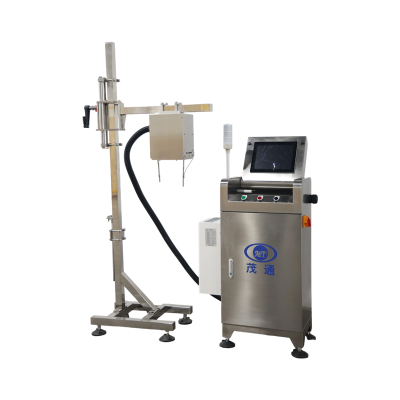Medicine bottle leak detection
The integrity of the seal on medicine bottles is crucial for ensuring the sterility and effectiveness of medicines. The table below summarizes the main leak detection methods, helping you quickly understand their characteristics and applicable scenarios.
| Detection Method | Core Principle | Applicable Packaging Type | Method Characteristics/Sensitivity |
| Vacuum Decay Method | A vacuum is drawn into the test chamber containing the sample, and a sensor monitors the pressure change (pressure increase) caused by leakage within the chamber | Suitable for rigid or flexible packaging such as vials, ampoules, pre-filled syringes, and infusion bottles | Non-destructive, quantitative; detects minute leaks (up to 3-5μm); conforms to ASTM standards and pharmacopoeia guidelines |
| High Voltage Discharge Method (HVLD) | High voltage is applied to conductive liquid containers, and the seal is determined by detecting changes in capacitance/current caused by leaks | Suitable for non-conductive packaging filled with conductive liquids (such as glass ampoules, plastic bottles, and pre-filled syringes) | Non-destructive, high sensitivity (detects leaks smaller than 3μm); particularly suitable for suspensions and high-viscosity liquids; fast testing speed |
| Pressure Decay Method | Applying pressure to the packaging and monitoring the pressure drop over a period of time to determine if a leak has occurred | Suitable for various containers such as plastic bottles, ampoules, and vials | Non-destructive and quantitative; suitable for scenarios where vacuuming is not possible or internal pressure testing is required |
| Tracer Solution Method (Color Water Method) | Creating a pressure difference between the inside and outside of a sample immersed in a colored solution (such as methylene blue solution) within a vacuum chamber, observing whether the colored solution penetrates into the packaging. Suitable for aluminum-plastic blister packaging, bottles, etc | Destructive, qualitative/semi-quantitative; intuitive operation, a traditional and commonly used method | however, it may be insensitive to extremely small leaks, and the results depend on human judgment |
| Bubble Method (Underwater Negative Pressure Method) | Immersing the sample in water and creating a vacuum, observing whether continuous bubbles are generated. Suitable for various soft and hard packaging | Destructive and qualitative | simple equipment, intuitive results; however, it is difficult to detect micro-leaks and is affected by the surface tension of water |
How to Choose the Appropriate Detection Method
The choice of method depends on your specific needs. The following principles can be considered: Regarding packaging type and contents: For plastic bottles, vacuum decay and pressure decay methods are commonly used and accurate choices. For glass ampoules, non-destructive quantitative methods such as high-voltage discharge (HVLD) and laser methods are preferred. For complex pre-filled syringes, special attention needs to be paid to fixing moving parts (such as the piston) during testing; vacuum decay and high-voltage discharge methods are often used in combination. If the drug is a suspension, emulsion, or high-viscosity liquid, high-voltage discharge (HVLD) is generally more effective because these liquid properties may cause missed detections by conventional methods such as vacuum decay.
Consider the testing purpose and standards: If 100% online testing of every product on the production line is required, then high-speed, automated methods (such as specially designed HVLD or vacuum decay equipment) are necessary. If it is only for sampling quality inspection or laboratory research, a more comprehensive and accurate benchtop device can be selected. Always refer to the relevant guidelines of pharmacopoeia regulations (such as the Chinese Pharmacopoeia, USP <1207>) to ensure that the method complies with compliance requirements.
Balancing Method Performance and Cost: High-throughput, high-sensitivity non-destructive testing equipment (such as HVLD and high-precision vacuum attenuation instruments) may require higher initial investment, but in the long run, they offer greater advantages in ensuring quality and reducing product loss. Traditional aqueous or bubble-based methods have lower costs, but limitations in sensitivity and objectivity. A comprehensive consideration of the rigor of quality control and budget is necessary.
Precautions During Testing: When conducting leak detection on pharmaceutical bottles, several aspects require special attention:
Importance of Positive Controls: Regardless of the method used, verifying the sensitivity (method detection limit) of the detection method using a known positive control sample with a specific size leak (such as a laser-drilled positive control) is crucial. This ensures your detection system is effective and reliable.
Personnel and Environmental Requirements: For methods relying on manual judgment (such as visual inspection in aqueous methods), standards may have specific requirements for operator vision (e.g., corrected vision and no color blindness) to reduce subjective error. Some precision tests may require control of the testing environment (such as temperature and humidity) to ensure repeatability and accuracy of results.
Data Integrity and Compliance: The modern pharmaceutical industry has stringent requirements for data integrity. Choosing testing instruments with automated data recording, storage, and audit trail capabilities can help companies better meet GMP (Good Manufacturing Practice) requirements.
Summary: The core of choosing a method for detecting leaks in pharmaceutical vials is to find the optimal balance between accuracy, efficiency, and cost-effectiveness based on product characteristics, quality standards, and actual production needs.
Hopefully, this information helps you better understand pharmaceutical vial leak detection. If you could share more information about your specific type of pharmaceutical packaging (e.g., vials, pre-filled syringes, or others) or testing scenario (e.g., online full inspection or sampling inspection), I could perhaps provide more targeted analysis.




